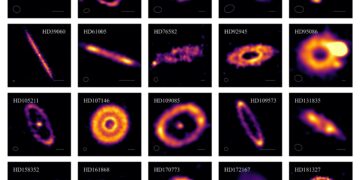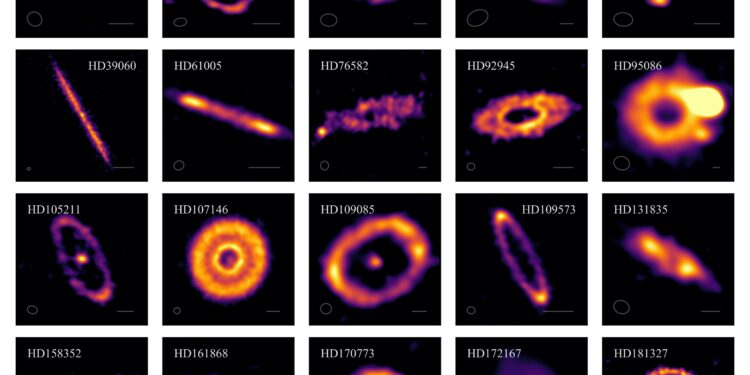The mysteries of the cosmos continue to unfold with the latest breakthrough by astrophysicists from Trinity College Dublin. For the first time, researchers have captured crystal-clear images of 74 exocomet belts orbiting nearby stars. These icy, rocky regions, akin to the Kuiper Belt in our solar system, hold invaluable clues about planetary system formation and evolution.
Exocomet Belts: What Are They?
Exocomet belts are regions of icy bodies, or exocomets, orbiting stars far beyond our solar system. These belts, often located tens to hundreds of astronomical units (au) from their host stars, are composed of rock and ice. In these frigid environments, temperatures range from -250 to -150 degrees Celsius, freezing most compounds, including water, into ice.
The study revealed that exocomets smash together within these belts, creating millimeter-sized pebbles that emit detectable light. These pebbles serve as signposts, allowing astronomers to map the belts and study their characteristics.
The REASONS Survey: A Technological Marvel
This landmark discovery was made possible through the REASONS (REsolved ALMA and SMA Observations of Nearby Stars) survey. Utilizing the Atacama Large Millimeter/submillimeter Array (ALMA) in Chile and the Submillimeter Array (SMA) in Hawaii, researchers observed millimeter and submillimeter wavelengths of light to capture high-resolution images.
The data provided unprecedented clarity, enabling scientists to locate and analyze exocomet belts across a wide sample of 74 nearby stars. These stars range from those just emerging from their formation to mature systems similar to our own solar system. The use of advanced telescopes allowed the team to unlock insights into these distant icy worlds, showcasing the power of modern astronomy.
Diversity in Exocomet Belts
The study uncovered remarkable diversity in the structure of exocomet belts. Some appeared as narrow rings, resembling the Kuiper Belt in our solar system, while others were wide disks. This variation hints at differences in the formation and evolutionary history of planetary systems.
Interestingly, some systems displayed multiple rings or eccentric structures. These configurations suggest the gravitational influence of unseen planets, whose presence alters the distribution of material within the belts.
Key Findings: Age, Distance, and Evolution
One of the most intriguing revelations of the REASONS survey is the relationship between the age and location of exocomet belts. Younger planetary systems exhibited higher concentrations of pebbles, while older systems showed a decline in material. This depletion occurs faster in belts closer to the central star, where higher gravitational forces and radiation accelerate the process.
Additionally, the study indirectly identified massive, unobservable objects—ranging from 140 km to moon-sized—within these belts.
Why This Discovery Is So Important
Understanding exocomet belts has profound implications for both astronomy and planetary science. First, these belts are the building blocks of planetary systems, offering a glimpse into the processes that shape planets and their environments.
Second, the discovery of diverse belt structures provides clues about the architecture of planetary systems. For instance, eccentric or multiple rings may signal the presence of hidden exoplanets.
The Science Behind the Discovery
The ability to image exocomet belts with such precision is a testament to advancements in observational astronomy. ALMA and SMA, two of the most powerful arrays in the world, detect electromagnetic radiation at millimeter and submillimeter wavelengths. This capability is crucial for observing cold, distant objects like exocomets, which emit faint signals.
By combining observations from both arrays, researchers were able to produce high-resolution images that reveal the intricate details of exocomet belts.
Future Research Directions
The REASONS survey is just the beginning of an exciting journey to explore the complexities of exocomet belts. Future research will focus on several key areas:
- Chemical Composition Analysis
Scientists aim to analyze the chemical makeup of exocometary material, shedding light on the building blocks of planets and potential sources of water and organics. - Exoplanet Detection
The structures within exocomet belts may reveal the presence of hidden exoplanets. - Comparative Studies
Comparing exocomet belts across different systems will provide insights into how factors like stellar age, type, and environment influence belt characteristics. - Advanced Observations
Upcoming telescopes, including JWST and ELTs, will allow for more detailed observations of exocomet belts.
What We Learn from Exocomet Belts
The study of exocomet belts teaches us about the interconnectedness of planetary systems. These icy belts are not merely debris fields; they are dynamic regions that shape and are shaped by their surroundings. They offer a window into the processes that govern the formation of planets, the delivery of water and organics, and the evolution of planetary environments.
Moreover, the diversity observed in exocomet belts underscores the uniqueness of each planetary system. Just as no two stars are identical, the belts and planets that orbit them exhibit a fascinating array of characteristics, reflecting the intricate dance of gravity, radiation, and time.
Conclusion
The imaging of 74 exocomet belts by astrophysicists from Trinity College Dublin marks a monumental step in our quest to understand the universe. This discovery not only unveils the hidden worlds of icy bodies orbiting distant stars but also provides a roadmap for future exploration. By studying these belts, we gain valuable insights into the origins and evolution of planetary systems, as well as the conditions that may support life.
Reference:
Astrophysicists reveal structure of 74 exocomet belts orbiting nearby stars in landmark survey









![Gamma-ray burst [GRB]. Credit: Cruz Dewilde/ NASA SWIFT.](https://nasaspacenews.com/wp-content/uploads/2025/05/gamma-ray-burst-credit-nasa-swift-cruz-dewilde-1-75x75.jpg)









